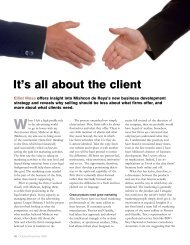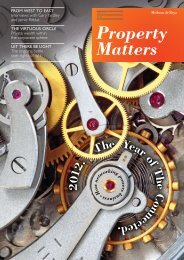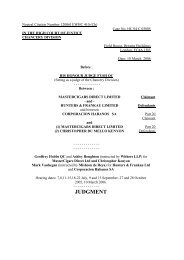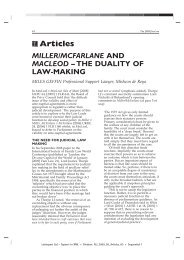Fashion & Retail Newsletter: Summer 2007 - Mishcon de Reya
Fashion & Retail Newsletter: Summer 2007 - Mishcon de Reya
Fashion & Retail Newsletter: Summer 2007 - Mishcon de Reya
Create successful ePaper yourself
Turn your PDF publications into a flip-book with our unique Google optimized e-Paper software.
AGEISMAND THEFASHIONWORLDFor all employers, the challenge is nowto adapt to a new business environment,where discrimination, harassment orvictimisation of employees, applicantsand contract workers on the grounds ofage is unlawful. The Employment Equality(Age) Regulations 2006 (the“Regulations”), which came into force inOctober 2006, contain a number offeatures which are unique indiscrimination legislation and whichemployers will not haveexperienced previously.The Regulations protect workers of allages, not just ol<strong>de</strong>r workers. Employerscan no longer take <strong>de</strong>cisions such as whoto recruit, promote, train or dismissbased on the age of the employee.Common business practices, likeemploying people in the age range ofthe customer <strong>de</strong>mographic or requiringemployees to wear the clothes sold bya store, may no longer be acceptable.There are certain circumstances whenemployers can treat people differentlybecause of their age, but suchcircumstances are very limited.Employers will have to show that thediscrimination was a proportionatemethod of achieving a legitimatebusiness purpose. Previousdiscrimination legislation has shown thatthis is a high hurdle to jump. Simplystating that it makes the business moreprofitable or is market practice will notexcuse discrimination.PROTECTING YOURBRAND WITH RCDConsumer businesses arebecoming increasinglyaware of the benefits ofprotecting their brandsthrough the RegisteredCommunity Design (RCD)in addition to the morewi<strong>de</strong>ly used CommunityTra<strong>de</strong> Mark (CTM).The tra<strong>de</strong> mark and <strong>de</strong>sign registrationsystems in Europe have a number ofcommon characteristics and can be usedin conjunction with each other tostrengthen the protection ofbran<strong>de</strong>d products.A recent case in Spain involved LouisVuitton and Calvin Klein acting jointly,using their respective RCDs against anindividual who had registered <strong>de</strong>signs inSpain that combined their respectivelogos. The Spanish registration for theDoing Business in StyleAt a minimum,employers shouldseek to foster aculture change...The best advice is for employers tostart to address what could bediscriminatory practices (whetherintentional or not) now, rather thanwaiting for problems to emerge. This isno small task. At a minimum, employersshould seek to foster a culture changeand ensure that policies for recruitment,selection, promotion, training, pay andother conditions of employment arereviewed and altered to remove anydiscriminatory practices.For further information, contact:Helen Croft+44 (0)20 7440 7065helen.croft@mishcon.com<strong>de</strong>signs was held to be invalid on thebasis that it used the famous fashionhouses’ distinctive signs.Brand owners continually attempt touse the tra<strong>de</strong> mark system as a way ofprotecting the shape of their goods andpackaging as well as the brand itself.However, it is often the case that thesemay be better protected by the RCD,which offers consi<strong>de</strong>rably broa<strong>de</strong>rprotection for new <strong>de</strong>signs than itsequivalent in many other jurisdictions.Doing Business in StyleCONTINUES ON BACK PAGE ➤2
CONTINUED FROM PAGE 2 ➤Summit House12 Red Lion SquareLondon WC1R 4QDTelephone +44 (0)20 7440 7000www.mishcon.comRCDs may be used to protect a threedimensional<strong>de</strong>sign, such as an article, aswell as two-dimensional <strong>de</strong>signs, such assurface pattern, character imagesor logos....protection is limitedto a maximum oftwenty years... it ispossible to register itas a CTM...In addition to its wi<strong>de</strong> scope,registration of community <strong>de</strong>signs is amore efficient and inexpensive processthan registration of CTMs. There is nosubstantive examination process and noformal opposition period.Although protection is limited to amaximum of twenty years, it is possibleto subsequently, or contemporaneously,register it as a CTM perhaps evenobtaining acquired distinctiveness inthe meantime.It may not always be appropriate tosecure protection of brands throughboth the RCD and CTM, but it is alwaysworth evaluating the overall benefitsand objectives of the two regimes and,where a business is seeking to protectits packaging or get-up, consi<strong>de</strong>ringwhether the RCD route would bemore suitable.For further information, contact:Conan Chitman+44 (0)20 7440 7110conan.chitham@mishcon.comIMPORTANTThis publication is only inten<strong>de</strong>d as a generalstatement of the law and no action should betaken in reliance on it without specificlegal advice.© <strong>Mishcon</strong> <strong>de</strong> <strong>Reya</strong> <strong>2007</strong>IT PROJECTS IN THERETAIL SECTOR –KEY LEGAL TIPS TOUNDERPIN SUCCESSIT is critical to success in many areas in the fashion & retail sector – fromensuring stock is in the right place at the right time to back office invoicingand payroll systems. So, meltdown of a retailer’s IT system has a seriouseffect on its business. Surprisingly, many such problems stem fromina<strong>de</strong>quately negotiated or poorly wor<strong>de</strong>d contracts.There are often no winners if an IT project goes wrong, as one retailer andits supplier learnt to their cost when they fell out over an £11 millionsoftware upgra<strong>de</strong>. Only during the course of the dispute did it becomeclear that each party had a very different view of what the supplier wassupposed to <strong>de</strong>liver. After two lengthy, expensive (and inconclusive) courtcases, the retailer was left without the system that it wanted and thesupplier was reportedly left out of pocket on fees.Many such projects fail because the customerrelies on what it expects to be <strong>de</strong>livered ratherthan the letter of the contract. So what can youdo to avoid such problems arising? ➤For further information, contact:Kiran Sandford+44 (0)20 7440 7066kiran.sandford@mishcon.com1. I<strong>de</strong>ally, you should treat thesupply contract as an integralstep in ensuring that yourstrategic IT project is <strong>de</strong>liveredsuccessfully, within budget and ontime (rather than a hurdle to beovercome before work starts).2. You should allow sufficient timefor negotiation (rather thanrushing to meet the supplier’s<strong>de</strong>adline for signature).3. Invest resources to ensure thatthe specification reflects all thesupplier's initial promises (toomany do not).4. For fixed price contracts, youshould ensure that the wordingdoes not leave room forhid<strong>de</strong>n extras.5. The contract should provi<strong>de</strong>sufficient incentive for thesupplier to <strong>de</strong>liver what youexpect and provi<strong>de</strong> a<strong>de</strong>quateprotection and compensation foryou if things go wrong.6. Your senior management orboard should receive reports onthe main technical and legal risksat all key stages of strategic ITprojects so that they can examinethe consequences of acceptingany risks carefully.7. Finally, consi<strong>de</strong>r not committingto one supplier too early on.If you have another supplierwaiting in the wings, you will bein a much stronger position if itbecomes apparent that thechosen supplier is not going to<strong>de</strong>liver what you expect.3
















